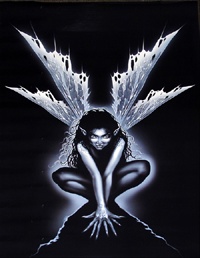Children were escorted from house to house with gifts of clove spiked apples and oranges which were laid in baskets of evergreen boughs and wheat stalks dusted with flour. The apples and oranges represented the sun, the boughs were symbolic of immortality, the wheat stalks portrayed the harvest, and the flour was accomplishment of triumph, light, and life. Holly, mistletoe, and ivy not only decorated the outside, but also the inside of homes. It was to extend invitation to Nature Sprites to come and join the celebration. A sprig of Holly was kept near the door all year long as a constant invitation for good fortune to pay visit to the residents.
The ceremonial Yule log was the highlight of the festival. In accordance to tradition, the log must either have been harvested from the householder's land, or given as a gift... it must never have been bought. Once dragged into the house and placed in the fireplace it was decorated in seasonal greenery, doused with cider or ale, and dusted with flour before set ablaze be a piece of last years log, (held onto for just this purpose). The log would burn throughout the night, then smolder for 12 days after before being ceremonially put out. Ash is the traditional wood of the Yule log. It is the sacred world tree of the Teutons, known as Yggdrasil. An herb of the Sun, Ash brings light into the hearth at the Solstice.
A different type of Yule log, and perhaps one more suitable for modern practitioners would be the type that is used as a base to hold three candles. Find a smaller branch of oak or pine, and flatten one side so it sets upright. Drill three holes in the top side to hold red, green, and white (season), green, gold, and black (the Sun God), or white, red, and black (the Great Goddess). Continue to decorate with greenery, red and gold bows, rosebuds, cloves, and dust with flour.
Deities of Yule are all Newborn Gods, Sun Gods, Mother Goddesses, and Triple Goddesses. The best known would be the Dagda, and Brighid, the daughter of the Dagda. Brighid taught the smiths the arts of fire tending and the secrets of metal work. Brighid's flame, like the flame of the new light, pierces the darkness of the spirit and mind, while the Dagda's cauldron assures that Nature will always provide for all the children.
Symbolism of Yule:
Rebirth of the Sun, The longest night of the year, The Winter Solstice, Introspect, Planning for the Future.
Symbols of Yule:
Yule log, or small Yule log with 3 candles, evergreen boughs or wreaths, holly, mistletoe hung in doorways, gold pillar candles, baskets of clove studded fruit, a simmering pot of wassail, poinsettias, christmas cactus.
Herbs of Yule:
Bayberry, blessed thistle, evergreen, frankincense holly, laurel, mistletoe, oak, pine, sage, yellow cedar.
Foods of Yule:
Cookies and caraway cakes soaked in cider, fruits, nuts, pork dishes, turkey, eggnog, ginger tea, spiced cider, wassail, or lamb's wool (ale, sugar, nutmeg, roasted apples).
Incense of Yule:
Pine, cedar, bayberry, cinnamon.
Colors of Yule:
Red, green, gold, white, silver, yellow, orange.
Stones of Yule:
Rubies, bloodstones, garnets, emeralds, diamonds.
Activities of Yule:
Caroling, wassailing the trees, burning the Yule log, decorating the Yule tree, exchanging of presents, kissing under the mistletoe, honoring Kriss Kringle the Germanic Pagan God of Yule
Spellworkings of Yule:
Peace, harmony, love, and increased happiness.
Deities of Yule:
Goddesses-Brighid, Isis, Demeter, Gaea, Diana, The Great Mother. Gods-Apollo, Ra, Odin, Lugh, The Oak King, The Horned One, The Green Man, The Divine Child, Mabon.
--Adapted by Akasha Ap Emrys For all her friends and those of like mind--
Copyright © 1997-99 Akasha, Herne and The Celtic Connection wicca.com. All rights reserved.
My personal wish for Yule
is about Peace
in our hearts,
in our homes,
in our lives
is about Peace
in our hearts,
in our homes,
in our lives







No comments:
Post a Comment